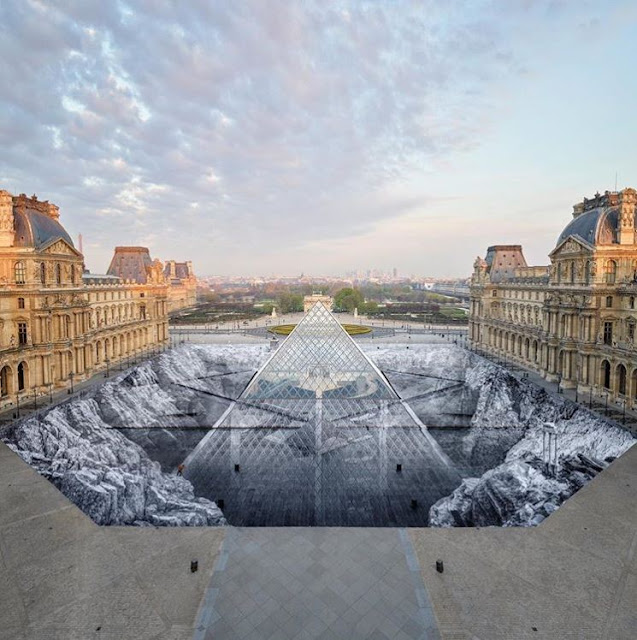Review: Treasures from the Wreck of the Unbelievable - Damien Hirst
Enchanting: the optimum word for the new Damien Hirst exhibition that opened its doors to the public this morning. The hotly anticipated and extremely secretive exhibition was split across two stunning Venetian venues: the Palazzo Grassi and the Punta della Dogana.
And so, the key question: what exactly was in the exhibition? The build-up to his latest work was shrouded in mystery and, other than being something to do with a mythical shipwreck, no one had any idea what it would entail.
Well, as you enter the exhibition you are greeted with some historical context (as well as an utterly colossal, jaw-dropping bronze statue):
In the mid-first century AD, an immense ship, the Apistos, set sail on behalf of a collector (previously a slave) named Cif Amotan II. Packed to the brim with various purchases and plunder and destined for a purpose-built temple, the Apistos never arrived and disappeared, becoming an historical myth. In 2008, a vast wreckage site was discovered off the coast of East Africa, amongst it, some of the most valuable and stunning pieces the world has ever seen.
Hirst’s diving expedition were the lucky ones and Treasures from the Wreck of the Unbelievable is a museum dedicated to the findings.
As you move through the rooms, the plunder on view is astounding: coral-ridden bronze statues, countless golden coins, strange, mythical creatures, the list goes on. Additionally, rooms along the way screen video content of the diving expedition itself and show the recovery of some of the most impressive pieces on show in both venues. Alongside, an ongoing commentary: an audio accompanying the diving footage and explaining some of the backstory as well as a continuous commentary from Hirst himself in the shape of small, subtle labels explaining the origins and myths behind many of the sometimes confusing and otherworldly sculptures in each of the rooms.
As you probably guessed, and in typically Hirst fashion, this whole exhibition is one enormously elaborate, incredibly orchestrated myth. Of course, this insane collection of items was not found at the bottom of the sea, neither does he want you to believe this. In fact, Hirst toys with your gullibility as you move around the galleries: as you begin, you almost fall for the trick, as you watch the real-life (but staged) footage of the divers collecting the materials from the ocean floor and read the cleverly written prose outlining both the myth and the recovery expedition itself. However, just as you fall prey to your imagination, Hirst quickly bursts the bubble, as you suddenly find yourself looking at another “discovery”, which is actually a coral-covered statue of Goofy or Walt Disney holding Mickey Mouse’s hand.
Such obvious blips and “mistakes" in the reality of the exhibition make the whole experience incredibly fun; you never know whether to keep believing and embracing the mythical storyline due to the fear of being jolted sharply from the surreal by one of Hirst’s jokes. Another example of his dry humour comes in the room filled to the brim with canvas sketches. Incredibly beautiful drawings, all framed across the gallery wall and sketched as a response to the myth by a Renaissance artist, but, on closer look, covered with tiny, quasi-unnoticeable automobile logos (Suzuki, Audi etc.) and all signed by the artist In this dream (an anagram for Damien Hirst).
The verdict? A hugely fun exhibition and an experience like no other. You will find yourself drawn into the mythical world of the Romans and Greeks before unpredictably laughing out loud at one of Hirst’s visible jokes: this is unlike any art gallery you will ever have visited. What’s more, the Venetian setting complements the whole thing: what better way to enhance this unique type of exhibition by setting it in a city synonymous with both water and sinister, ancient art. As aforementioned, you will be toyed with as you wander around this exhibition, but that’s the point, embrace and enjoy it, it’s fantastic.
Of course, there will be those that belittle this return from Hirst as stupid, over-the-top and pretentious. However, the level of detail Hirst has shown on the big stage here is astounding: from the tiny artistic details on every single piece visible in the exhibition, to the minute detail in the written copy that accompanies every artistic joy, to the farcically high level of logistics it would have taken to stage an entire diving expedition in the middle of the Indian Ocean (just think about putting all of these enormous sculptures at the bottom of the ocean and then hauling them back up again), this truly is an exceptional show.
Check out some of Qulture’s photos below and keep an eye on the reviews to see how it is received by critics. From our side, it’s stupendously fun and if you find yourself in Venice in the next six months, it’s a must.
And so, the key question: what exactly was in the exhibition? The build-up to his latest work was shrouded in mystery and, other than being something to do with a mythical shipwreck, no one had any idea what it would entail.
Well, as you enter the exhibition you are greeted with some historical context (as well as an utterly colossal, jaw-dropping bronze statue):
In the mid-first century AD, an immense ship, the Apistos, set sail on behalf of a collector (previously a slave) named Cif Amotan II. Packed to the brim with various purchases and plunder and destined for a purpose-built temple, the Apistos never arrived and disappeared, becoming an historical myth. In 2008, a vast wreckage site was discovered off the coast of East Africa, amongst it, some of the most valuable and stunning pieces the world has ever seen.
Hirst’s diving expedition were the lucky ones and Treasures from the Wreck of the Unbelievable is a museum dedicated to the findings.
As you move through the rooms, the plunder on view is astounding: coral-ridden bronze statues, countless golden coins, strange, mythical creatures, the list goes on. Additionally, rooms along the way screen video content of the diving expedition itself and show the recovery of some of the most impressive pieces on show in both venues. Alongside, an ongoing commentary: an audio accompanying the diving footage and explaining some of the backstory as well as a continuous commentary from Hirst himself in the shape of small, subtle labels explaining the origins and myths behind many of the sometimes confusing and otherworldly sculptures in each of the rooms.
As you probably guessed, and in typically Hirst fashion, this whole exhibition is one enormously elaborate, incredibly orchestrated myth. Of course, this insane collection of items was not found at the bottom of the sea, neither does he want you to believe this. In fact, Hirst toys with your gullibility as you move around the galleries: as you begin, you almost fall for the trick, as you watch the real-life (but staged) footage of the divers collecting the materials from the ocean floor and read the cleverly written prose outlining both the myth and the recovery expedition itself. However, just as you fall prey to your imagination, Hirst quickly bursts the bubble, as you suddenly find yourself looking at another “discovery”, which is actually a coral-covered statue of Goofy or Walt Disney holding Mickey Mouse’s hand.
Such obvious blips and “mistakes" in the reality of the exhibition make the whole experience incredibly fun; you never know whether to keep believing and embracing the mythical storyline due to the fear of being jolted sharply from the surreal by one of Hirst’s jokes. Another example of his dry humour comes in the room filled to the brim with canvas sketches. Incredibly beautiful drawings, all framed across the gallery wall and sketched as a response to the myth by a Renaissance artist, but, on closer look, covered with tiny, quasi-unnoticeable automobile logos (Suzuki, Audi etc.) and all signed by the artist In this dream (an anagram for Damien Hirst).
The verdict? A hugely fun exhibition and an experience like no other. You will find yourself drawn into the mythical world of the Romans and Greeks before unpredictably laughing out loud at one of Hirst’s visible jokes: this is unlike any art gallery you will ever have visited. What’s more, the Venetian setting complements the whole thing: what better way to enhance this unique type of exhibition by setting it in a city synonymous with both water and sinister, ancient art. As aforementioned, you will be toyed with as you wander around this exhibition, but that’s the point, embrace and enjoy it, it’s fantastic.
Of course, there will be those that belittle this return from Hirst as stupid, over-the-top and pretentious. However, the level of detail Hirst has shown on the big stage here is astounding: from the tiny artistic details on every single piece visible in the exhibition, to the minute detail in the written copy that accompanies every artistic joy, to the farcically high level of logistics it would have taken to stage an entire diving expedition in the middle of the Indian Ocean (just think about putting all of these enormous sculptures at the bottom of the ocean and then hauling them back up again), this truly is an exceptional show.
Check out some of Qulture’s photos below and keep an eye on the reviews to see how it is received by critics. From our side, it’s stupendously fun and if you find yourself in Venice in the next six months, it’s a must.










Comments
Post a Comment